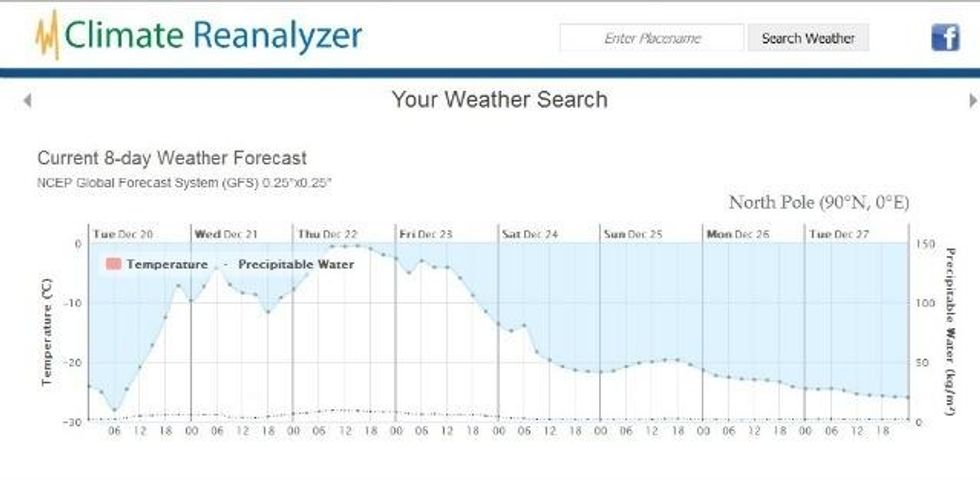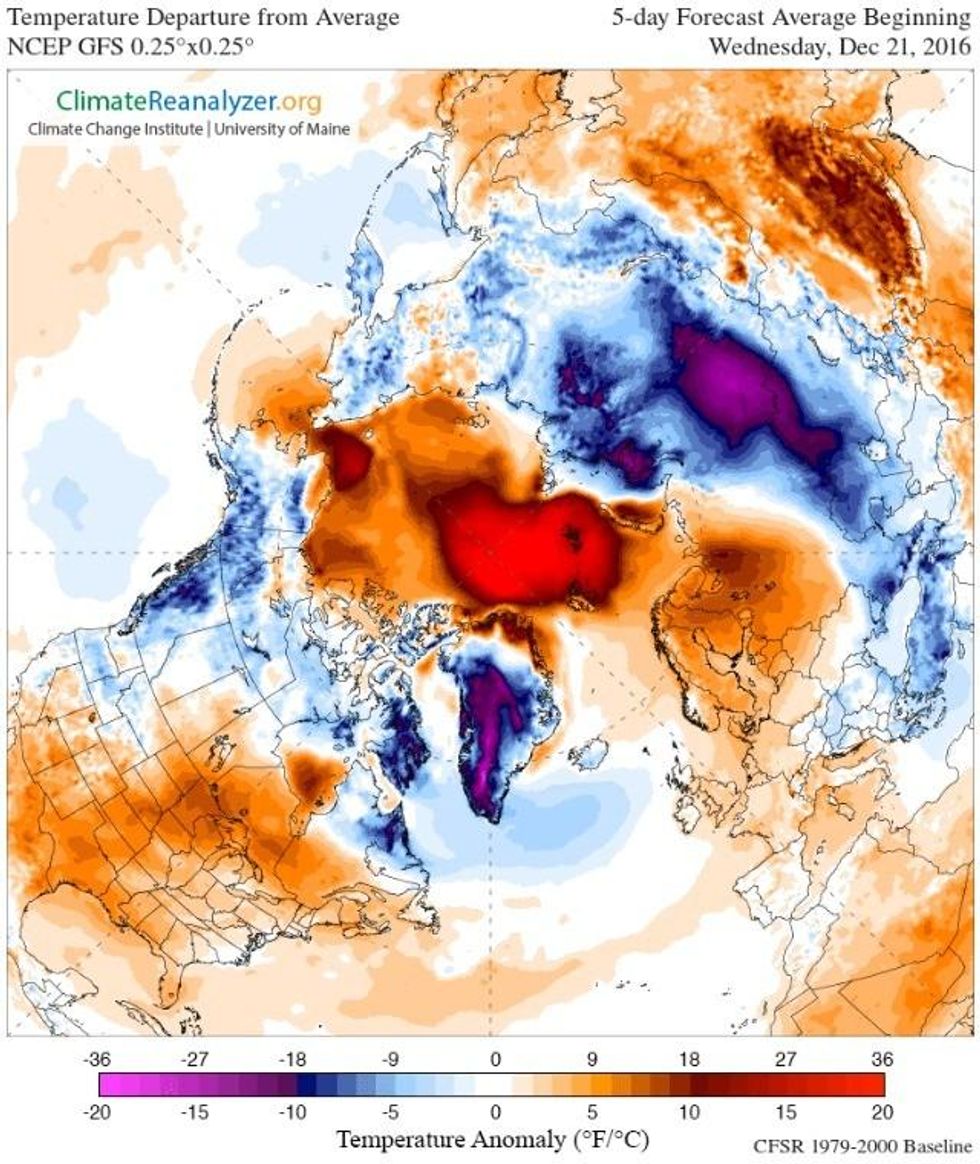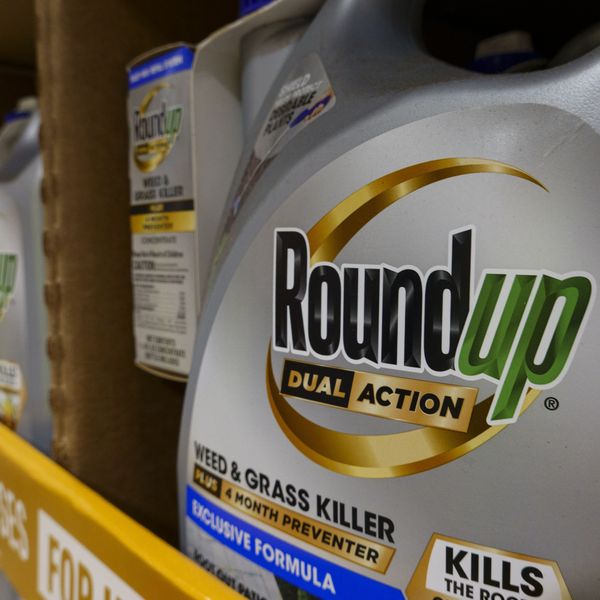Sorry, Santa: North Pole Temps Could Climb 50 Degrees Above Normal
Warmer than usual temperatures expected after Arctic sea ice extent hit a record low
Santa will likely be feeling toasty as he does his final checks on the naughty-or-nice list because temperatures at the North Pole on Thursday are forecast to be as much as 50degF above normal.
Temperatures are expected to climb to near the freezing point of 32degF, computer models show.


The Washington Post also notes: "For the second year in a row in late December and for the second time in as many months, temperatures in the high Arctic will be freakishly high compared to normal."
Meteorologist Jeff Berardelli explains that the current "warming is being caused by a strong storm near Greenland pumping warm air north ahead of the storm center." Mashable's science editor, Andrew Freedman, adds: "Record low levels of sea ice in the Arctic are also contributing to the record high temperatures, along with a weakened polar vortex that has pulled the most frigid air out of the Arctic and redistributed it into North America and Eurasia."
Indeed, last month Arctic sea ice extent hit a record low and the ice experienced a "nearly unprecedented" retreat that "coincided with a period of remarkable warmth across the region, with air temperatures 30degF-35degF above normal," the National Oceanic and Atmospheric Administration (NOAA) said.
\u201cToday, very old ice is extremely rare in the Arctic. #Santa and the elves are preparing: https://t.co/JmSl46XV20\u201d— NOAA Climate.gov (@NOAA Climate.gov) 1482071440
In its latest Arctic Report Card, NOAA said last week that the average air temperatures for the region were "unprecedented" and that "Arctic temperatures continue to increase at double the rate of the global temperature increase."
"Rarely have we seen the Arctic show a clearer, stronger, or more pronounced signal of persistent warming and its cascading effects on the environment than this year," added Jeremy Mathis, director of NOAA's Arctic Research Program.
Meanwhile, Santa's reindeer aren't doing so well either.
A new study finds that reindeer in Svalbard, an archipelago of Norway in the Arctic Ocean, are shrinking as a result of warming temperatures.
Winter snows may now fall as rain, leaving a sheet of ice that blocks the plants the reindeer would normally be able to access by brushing off snow. That means the reindeer may starve or give birth to stunted carves, who in turn may produce stunted calves.
An Urgent Message From Our Co-Founder
Dear Common Dreams reader, The U.S. is on a fast track to authoritarianism like nothing I've ever seen. Meanwhile, corporate news outlets are utterly capitulating to Trump, twisting their coverage to avoid drawing his ire while lining up to stuff cash in his pockets. That's why I believe that Common Dreams is doing the best and most consequential reporting that we've ever done. Our small but mighty team is a progressive reporting powerhouse, covering the news every day that the corporate media never will. Our mission has always been simple: To inform. To inspire. And to ignite change for the common good. Now here's the key piece that I want all our readers to understand: None of this would be possible without your financial support. That's not just some fundraising cliche. It's the absolute and literal truth. We don't accept corporate advertising and never will. We don't have a paywall because we don't think people should be blocked from critical news based on their ability to pay. Everything we do is funded by the donations of readers like you. Will you donate now to help power the nonprofit, independent reporting of Common Dreams? Thank you for being a vital member of our community. Together, we can keep independent journalism alive when it’s needed most. - Craig Brown, Co-founder |
Santa will likely be feeling toasty as he does his final checks on the naughty-or-nice list because temperatures at the North Pole on Thursday are forecast to be as much as 50degF above normal.
Temperatures are expected to climb to near the freezing point of 32degF, computer models show.


The Washington Post also notes: "For the second year in a row in late December and for the second time in as many months, temperatures in the high Arctic will be freakishly high compared to normal."
Meteorologist Jeff Berardelli explains that the current "warming is being caused by a strong storm near Greenland pumping warm air north ahead of the storm center." Mashable's science editor, Andrew Freedman, adds: "Record low levels of sea ice in the Arctic are also contributing to the record high temperatures, along with a weakened polar vortex that has pulled the most frigid air out of the Arctic and redistributed it into North America and Eurasia."
Indeed, last month Arctic sea ice extent hit a record low and the ice experienced a "nearly unprecedented" retreat that "coincided with a period of remarkable warmth across the region, with air temperatures 30degF-35degF above normal," the National Oceanic and Atmospheric Administration (NOAA) said.
\u201cToday, very old ice is extremely rare in the Arctic. #Santa and the elves are preparing: https://t.co/JmSl46XV20\u201d— NOAA Climate.gov (@NOAA Climate.gov) 1482071440
In its latest Arctic Report Card, NOAA said last week that the average air temperatures for the region were "unprecedented" and that "Arctic temperatures continue to increase at double the rate of the global temperature increase."
"Rarely have we seen the Arctic show a clearer, stronger, or more pronounced signal of persistent warming and its cascading effects on the environment than this year," added Jeremy Mathis, director of NOAA's Arctic Research Program.
Meanwhile, Santa's reindeer aren't doing so well either.
A new study finds that reindeer in Svalbard, an archipelago of Norway in the Arctic Ocean, are shrinking as a result of warming temperatures.
Winter snows may now fall as rain, leaving a sheet of ice that blocks the plants the reindeer would normally be able to access by brushing off snow. That means the reindeer may starve or give birth to stunted carves, who in turn may produce stunted calves.
Santa will likely be feeling toasty as he does his final checks on the naughty-or-nice list because temperatures at the North Pole on Thursday are forecast to be as much as 50degF above normal.
Temperatures are expected to climb to near the freezing point of 32degF, computer models show.


The Washington Post also notes: "For the second year in a row in late December and for the second time in as many months, temperatures in the high Arctic will be freakishly high compared to normal."
Meteorologist Jeff Berardelli explains that the current "warming is being caused by a strong storm near Greenland pumping warm air north ahead of the storm center." Mashable's science editor, Andrew Freedman, adds: "Record low levels of sea ice in the Arctic are also contributing to the record high temperatures, along with a weakened polar vortex that has pulled the most frigid air out of the Arctic and redistributed it into North America and Eurasia."
Indeed, last month Arctic sea ice extent hit a record low and the ice experienced a "nearly unprecedented" retreat that "coincided with a period of remarkable warmth across the region, with air temperatures 30degF-35degF above normal," the National Oceanic and Atmospheric Administration (NOAA) said.
\u201cToday, very old ice is extremely rare in the Arctic. #Santa and the elves are preparing: https://t.co/JmSl46XV20\u201d— NOAA Climate.gov (@NOAA Climate.gov) 1482071440
In its latest Arctic Report Card, NOAA said last week that the average air temperatures for the region were "unprecedented" and that "Arctic temperatures continue to increase at double the rate of the global temperature increase."
"Rarely have we seen the Arctic show a clearer, stronger, or more pronounced signal of persistent warming and its cascading effects on the environment than this year," added Jeremy Mathis, director of NOAA's Arctic Research Program.
Meanwhile, Santa's reindeer aren't doing so well either.
A new study finds that reindeer in Svalbard, an archipelago of Norway in the Arctic Ocean, are shrinking as a result of warming temperatures.
Winter snows may now fall as rain, leaving a sheet of ice that blocks the plants the reindeer would normally be able to access by brushing off snow. That means the reindeer may starve or give birth to stunted carves, who in turn may produce stunted calves.

